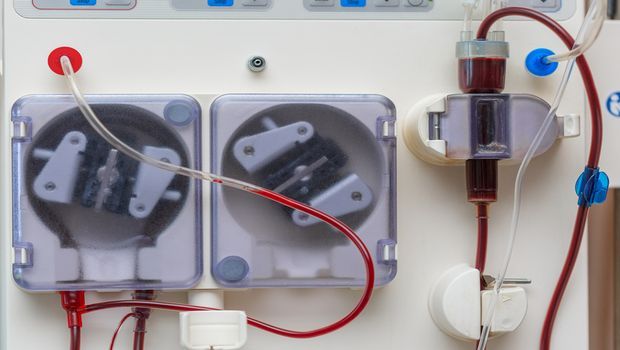Catheters Linked to Most Bloodstream Infections in Dialysis Patients

Using catheters to access the blood during hemodialysis continues to be linked with increased rates of bloodstream infections, according to a recent analysis of data from U.S. dialysis facilities. The findings appear in an upcoming issue of the Clinical Journal of the American Society of Nephrology (CJASN).
Individuals who undergo hemodialysis are at increased risk of developing infections due to the repeated need to access their blood. Experts recommend an arteriovenous fistula, which is created by connecting patient’s own vein and artery to form a long-lasting site through which blood can be removed and returned. Alternatively, a patient may use an arteriovenous graft, which is a plastic conduit between an artery and a vein. A smaller number of patients use a catheter instead of an arteriovenous fistula or graft for various reasons, including inadequate preparation for dialysis or avoidance of surgery.
The Centers for Disease Control and Prevention (CDC) conducts surveillance for infections in hemodialysis patients using the National Healthcare Safety Network (NHSN), and such information is used by the Centers for Medicare & Medicaid Services as part of the End-Stage Renal Disease Quality Incentive Program (QIP) to assess dialysis facility performance.
In their recent analysis of information gathered from 2014, the CDC’s Duc Bui Nguyen, MD and his colleagues noted that 6,005 outpatient hemodialysis facilities reported data for a total of 160,971 dialysis events including 29,516 bloodstream infections (BSIs); 149,722 intravenous antimicrobial starts; and 38,310 episodes of pus, redness, or increased swelling at the hemodialysis access site.
The team found that 77 percent of BSIs were related to accessing patients’ blood. Most-63 percent of BSIs and 70 percent of access-related BSIs-occurred in patients with a central venous catheter. BSI and other dialysis event rates were also highest among patients using central venous catheters. Staphylococcus aureus was the most commonly isolated BSI pathogen (31 percent), and 40 percent of S. aureus isolates tested were resistant to the antibiotic methicillin.
“We now have a clearer picture of the rates and types of infections hemodialysis patients in the United States are experiencing-nearly all U.S. outpatient hemodialysis facilities are participating in CDC’s NHSN Dialysis Event surveillance,” said Nguyen. “Our findings emphasize the need for hemodialysis facilities to improve infection prevention and vascular access care practices.”
In an accompanying editorial, Dana Miskulin, MD, (Tufts University School of Medicine) and Ambreen Gul, MD, (Dialysis Clinic Inc.) noted that a major problem to the available data is that event reporting is based on an honors system, with dialysis units reporting their own information. “We make a plea to the dialysis community to ‘clean up’ the data, so that the QIP is fairer for all and to enable the full potential of these data, both for improving care now and for generating new evidence to provide future opportunities to improve care and outcomes, to be realized,” they wrote.
Study co-authors include Alicia Shugart, MA, Christi Lines, MPH, Ami Shah, MPH, Jonathan Edwards, MStat, Daniel Pollock, MD, Dawn Sievert, PhD, and Priti Patel, MD, MPH.
The article, “National Healthcare Safety Network (NHSN) Dialysis Event Surveillance Report for 2014,” appeared online at http://cjasn.asnjournals.org/ on June 29, 2017, doi: 10.2215/CJN.11411116.
The editorial, “Infection Monitoring in Dialysis Units: A Plea for ‘Cleaner’ Data,” appeared online at http://cjasn.asnjournals.org/ on June 29, 2017.
Source Newsroom: American Society of Nephrology (ASN)